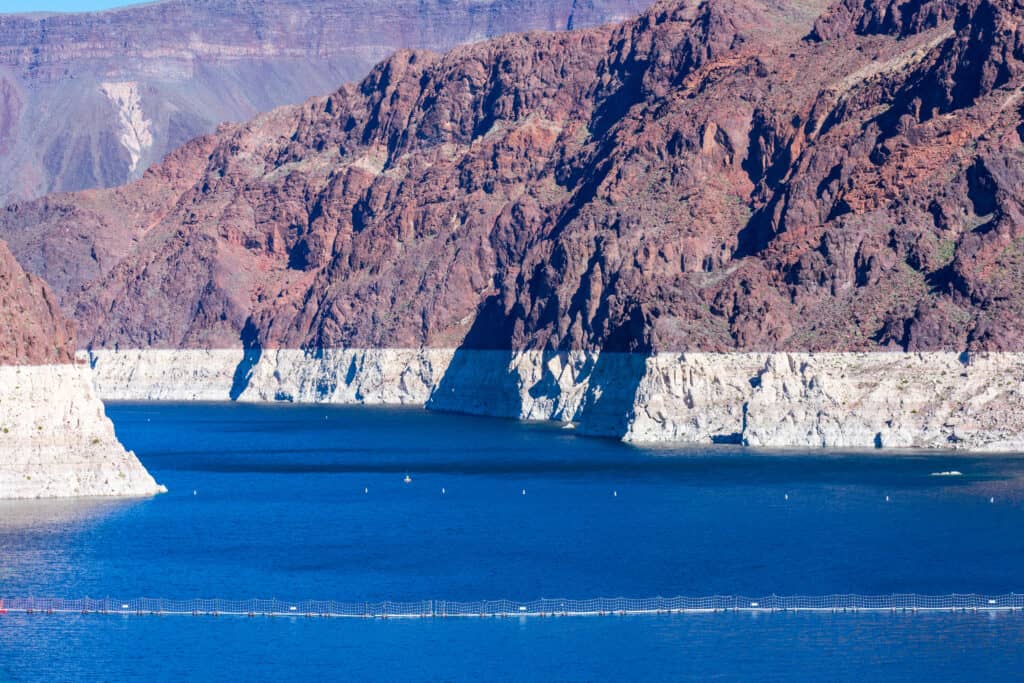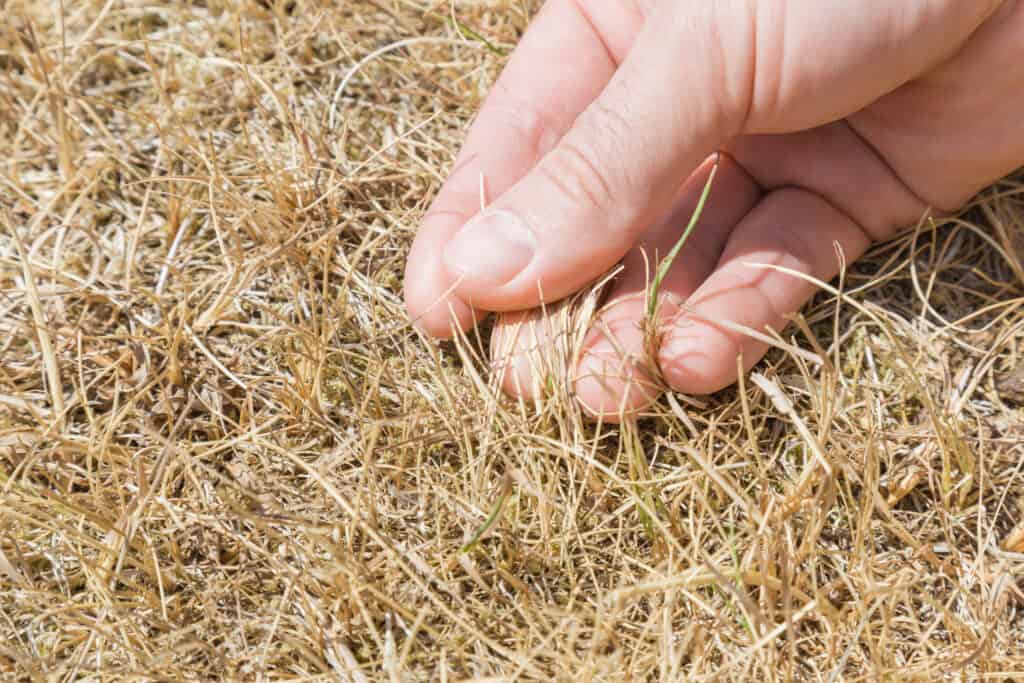Officials in California are getting serious about policing water usage according to an article in the Wall Street Journal. It doesn’t matter how rich you are, or how well known you are, your lawns will have to be brown along with everyone else’s. In fact, the Calabasas region in northwest Los Angeles County now has some of the brownest lawns in the US. Some residents are finding it hard to adjust with one, Siran Galstian, saying “My kids are asking me, what is going wrong with this grass?” I have tears in my eyes, because I love the grass and they like playing in it.” This affluent area nestled in the foothills of the Santa Monica Mountains is seeing some major changes in how this precious natural resource can be used.
California Water Supply

Reservoirs that feed the west including Lake Mead are at historically low levels.
©iStock.com/Michael Vi
California is one of the most highly altered areas of the planet in terms of hydrology. In simple terms, this means that water is moved from one place to another in this state more than anywhere else. Much of the southern area of California would naturally be desert and receives very little rainfall. Therefore, a lot of water has to be moved in to supply the human population here and make the environment look so green. As a result, California uses more groundwater than any other US state.
Water is pumped from reservoirs and from underground but this is a finite resource and groundwater basins are not getting recharged as much as they should. According to some estimates, California pumps 2 million more acre-feet of water than is recharged every year. It’s easy to see that this situation is not sustainable.
There have been two serious droughts in California in the last 10 years. The current one is so serious that the authorities are taking steps to limit water use. This year, California has seen warmer than average temperatures thanks partly to climate change and the lowest rainfall ever recorded. The vegetation is tinder dry and devastating wild fires have ripped through parts of the state.
Drought Control Measures in California
The administration of the water supply in California is as complex as the distribution system. Many agencies at the federal, state, and local level are involved.
For the last two years, the California Department of Water Resources has ordered that water shipments to cities are cut by 95%. This particular authority manages the supply from the Sierra Nevada snowpack which covers about 15 million acre-feet and is the state’s largest surface reservoir.
The Role of Water Cops

Aquaducts like in the image above carry water from far off places to reach cities like Los Angeles.
©iStock.com/iofoto
Restrictions on the use of water for non-essential purposes are an important part of the water conservation efforts and everyone is expected to play their part. Restrictions are particularly tight in those districts that rely mainly on reservoirs for their water supplies. The Las Virgenes Municipal Water District is one such zone and serves the 77,000 residents who live in and around Calabasas. Here, you can only water outdoors for eight minutes on one day of the week. These regulations are policed by so-called “water cops,” who are on the lookout for people flouting the laws.
Water cops patrol the huge multi-million dollar mansions that celebrities like Drake and Will Smith call home. They are on the lookout for signs of violations which would include deep green lawns or trickling water. They also investigate complaints of non-compliance received by neighbors and passersby. The district spokesman for the force is Mike McNutt and he explains to the WSJ that each property has an acceptable ‘water budget’ based on its size and how many people live there. If usage is repeatedly above that budget (as measured by electronic meter readings), punishments can be handed out and these include warning notices (more than 5,000 have been sent already), fines, fitting flow restriction devices that make it impossible to water lawns and even cutting off the water supply. David Pedersen, general manager of the district, describes this as “a necessary part of what we do.”
Water Cops Taking Action

Water cops have been watching mansions near Los Angeles for signs of over-watering.
©iStock.com/tupungato
This is no idle threat. The water cops have not hesitated to take action where needed and there have been some rich and high-profile casualties of the process. For example, it is reported that Kim Kardashian has been warned that her seven-bedroom Tuscan mansion in Hidden Hills could have its outdoor irrigation turned off following multiple violations. However, this is denied by her spokesperson who disputes the district’s public records on water use and says that they have worked very hard to reduce usage, including repairing leaks.
Another report mentions the $18 million home belonging to Hollywood legend Sylvester Stallone and his wife Jennifer Flavin. It was allegedly 351% over its allocated water budget for May. Mr. Stalone’s lawyer argues that water is necessary to maintain 500 mature trees alive and we are yet to find out what the outcome will be.
Is This the End of Lawns in California?

As the water crisis accelerates lawns are going dry across California.
©iStock.com/FotoDuets
What happens to a lawn when it does not get any water? According to local lawn expert, Bharat Shah of Colorful Gardens Center in Agoura Hills, lawns that do not get water at least three days a week will either become dormant or die. He also told the WSJ that a lack of water will affect trees which reduces shade and raises the temperature which will increase the risk of fire.
One of the other concerns relates to how the lawns will look. However, Felicia Marcus, former director of the State Water Resources Control Board, has no patience for this viewpoint, saying “The idea of having these lush green carpets that soak up precious water as a badge of honor should be a badge of shame.” The Metropolitan Water District of Southern California also argues that outdoor irrigation accounts for up to 85% of urban water use and is, therefore, a legitimate target for water conservation measures.
What Are the Alternatives?
A viable alternative would be to replace grass with native Californian plants (e.g. sage, lilacs and poppies), that use up 70% less water compared to lawns. This has already happened on a large scale in Las Vegas encouraged by rebates from the Southern Nevada Water Authority. It is estimated that billions of gallons have been saved! In response to rapidly falling water levels in Lake Mead, the Nevada Legislature now requires most properties to remove their grass lawns. A similar approach in California started five years ago saw nearly 200 million square feet of lawns being removed which has saved more than seven billion gallons of water a year.
Another possibility is to keep your lawn but not water it so much. Some would argue that lawns are currently over-watered and that if everyone cut back a little there would be more water to do around. This may be achieved using a sliding scale of pricing.
The Moulton Niguel Water District in Orange County has tried a ‘water budget’ approach where customers are charged more if they go over a certain limit of water usage.
Summing up….
Drought is a fact of life for Californians and the current situation is not sustainable. It appears that some progress is being made towards reducing water consumption in California with Los Angeles achieving reduced consumption levels and introducing new limits.
The combination of enforcement and education may be working. The best way to achieve success will be to convince the population to co-operate. Sometimes, very simple adjustments to leaking sprinklers and toilets can achieve impressive results. With everyone on board, it is likely that faster progress can be made.
The photo featured at the top of this post is © iStock.com/iofoto
FAQs (Frequently Asked Questions)
What’s causing the water shortage in California?
The water shortage has been caused by a series of droughts that are partly connected with climate change. Also, the way that water is moved around the state is complex and usage is high which adds to the problems.
How is water wasted in California?
Most people agree that leaks should be repaired and that these are a waste of water. However, there is an on-going debate about the role of watering lawns. Some people see this as a waste of water and some do not.
What are the alternatives to a lawn for Californians?
Californians who have decided to remove their lawns could replace them with native Californian plants (such as the Californian poppy) that have evolved to flourish on very little water.
Thank you for reading! Have some feedback for us? Contact the AZ Animals editorial team.







